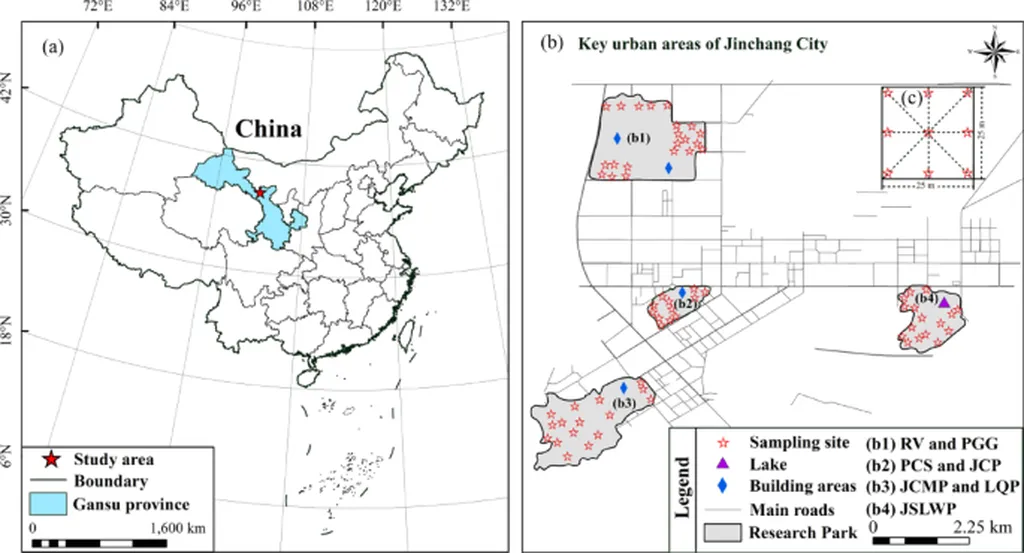In the heart of Lanzhou, a city nestled in the Yellow River valley of China, a groundbreaking study is shedding light on the hidden dangers lurking beneath urban green spaces. Led by Jun Li from the School of Environment and Urban Construction at Lanzhou City University, the research, published in the journal *Ecotoxicology and Environmental Safety* (translated as “生态毒理学与环境安全”), is unraveling the complex web of heavy metal contamination and its ecological risks, with implications that resonate far beyond the city’s borders.
Urbanization has left an indelible mark on the environment, and heavy metal contamination is a significant concern. Li’s study focuses on urban green spaces, areas often perceived as havens of tranquility and safety. However, the reality is more complex. “We found that the concentrations of several heavy metals, including cadmium (Cd), copper (Cu), mercury (Hg), lead (Pb), and zinc (Zn), exceeded local soil background values,” Li explains. The exceedance rates were alarming, with Cd, Hg, Pb, and Zn showing rates of 90.91%, 94.95%, 80.81%, and 87.88% respectively.
The study employed a sophisticated blend of machine learning techniques, including self-organizing maps (SOM) super-clustering and random forest (RF) methods, integrated with positive matrix factorization (PMF). This powerful combination allowed the researchers to quantify the sources of soil heavy metals and assess probabilistic contamination levels using Monte Carlo simulations (MCS). “By integrating these advanced techniques, we were able to pinpoint the primary sources of heavy metal contamination, which include traffic emissions, industrial activities, and coal combustion,” Li notes.
The ecological risks posed by these heavy metals are not to be underestimated. The study found that Cd and Hg pose the greatest ecological risks, primarily stemming from industrial activities and coal combustion. This finding is particularly relevant to the energy sector, which relies heavily on coal and other industrial processes. As the world grapples with the transition to cleaner energy sources, understanding and mitigating the environmental impacts of current practices is crucial.
The spatial patterns of heavy metal contamination revealed in the study are also significant. Elevated concentrations of Zn, Cd, Pb, and Hg were linked to industrial activities and urban development, highlighting the need for targeted remediation efforts. “Our findings provide important insights for developing source-specific remediation strategies to mitigate and manage heavy metal pollution in urban green spaces,” Li states.
The implications of this research extend beyond Lanzhou. As urbanization continues to expand globally, the need for effective environmental monitoring and management becomes ever more pressing. The integration of machine learning techniques with traditional environmental assessment methods offers a promising approach to tackling these challenges. “This study demonstrates the potential of advanced data analysis techniques in environmental research,” Li says. “By leveraging these tools, we can gain a deeper understanding of environmental issues and develop more effective solutions.”
For the energy sector, the study underscores the importance of addressing heavy metal contamination associated with industrial activities and coal combustion. As the world moves towards a more sustainable future, the need for cleaner energy sources and more stringent environmental regulations will only grow. The insights gained from this research can inform policy decisions and guide the development of more sustainable practices.
In conclusion, Jun Li’s research represents a significant step forward in our understanding of heavy metal contamination in urban green spaces. By combining advanced machine learning techniques with traditional environmental assessment methods, the study provides valuable insights into the sources and ecological risks of heavy metal pollution. The findings have important implications for the energy sector and highlight the need for targeted remediation efforts. As the world continues to grapple with the challenges of urbanization and environmental degradation, this research offers a beacon of hope and a roadmap for a more sustainable future.

